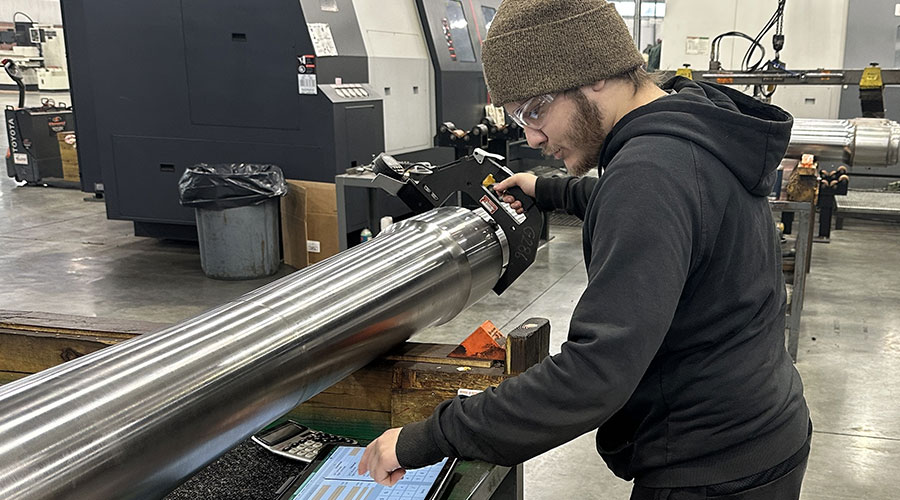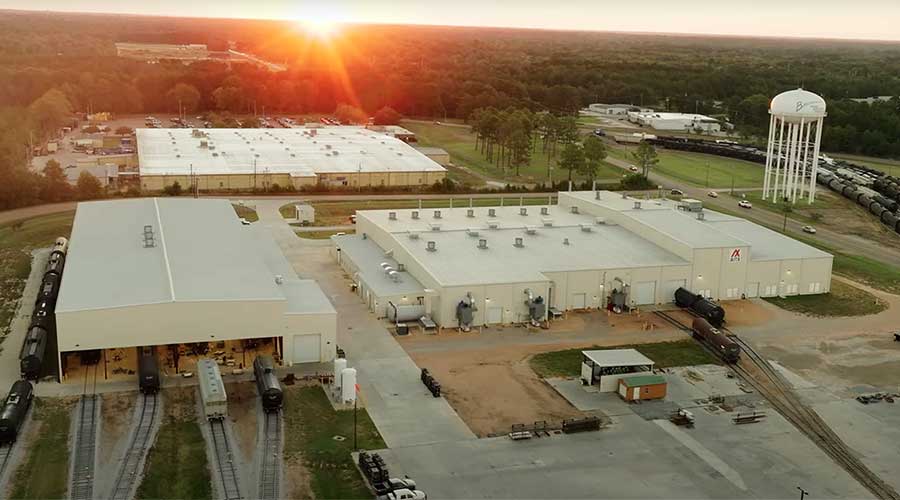Stay updated on news, articles and information for the rail industry
March 2007
Rail News: Mechanical
Railroads think strategically on the fuel front
By Robert J. Derocher
Folks who help North America’s railroads monitor and otherwise manage their fuel use are pretty busy these days. Given fuel’s unpredictable price swings and the increased consumption that corresponds with strong traffic volumes, suppliers who seek to answer railroads’ call likely will get even busier.
“The railroads have operated a long time with less information, unlike shippers like UPS and some of the trucking companies,” says David Baker, president of Lat-Lon L.L.C., which offers a variety of wireless monitoring and tracking solutions to the transportation industry. “So, there’s a catch-up process that’s going on right now.”
How are roads doing it? Strategies range from implementing Global Positioning System technology to ramping up rail-grinding procedures to simply doing a better job of making sure all employees keep conservation front and center.
“We’ve really tried to keep consumption under control,” says Garrick Francis, CSX Corp.’s director of financial communications. “Last year, the average price of diesel fuel was $1.86 [per gallon]. In 2005, it was $1.31.”
The Class I Response
That 40 percent cost increase prompted CSX to do a better job of curbing consumption. Even though the Class I’s traffic increased by 8.5 billion gross ton-miles in 2006, fuel consumption held steady at about 600 million gallons.
And despite a “modest increase” in fuel consumption, Norfolk Southern Corp. registered a $250 million increase in fuel expenses in 2006, says H.C. Wolf, vice chairman and chief financial officer. The bulk of the increase was due to a $129 million loss in fuel hedging benefits from a year earlier.
Although railroads have been able to recoup some of their costs through fuel surcharges assessed to shippers, a Surface Transportation Board ruling in January dramatically reduced those surcharge opportunities.
The rule prohibits railroads from assessing surcharges as a percentage calculation of a shipper’s base rate — a manner that doesn’t correlate with actual fuel costs for specific rail shipments, the STB said. In addition, the rule prohibits “double dipping,” a practice through which railroads apply a fuel surcharge and rate increase to the same traffic based on a cost index with a fuel component.
The decision, which also calls for the STB to monitor fuel surcharge practices by imposing mandatory reporting requirements on all Class Is, takes into account 73 comments the board received after issuing a notice of proposed rulemaking in August 2006.
So, with the potential for greater fuel costs looming larger, roads are turning more toward reduced consumption as a path to savings.
For CSX, that means continuing to install Auxiliary Power Units (APU) from Teleflex Power Systems, which in November 2006 acquired Ecotrans Technologies Inc., a supplier of locomotive anti-idling and emissions reductions solutions for the railroad industry; and Automatic Engine Stop/Start (AESS) technology on locomotives.
The Class I equipped about 1,500 locomotives with APUs in 2006; 1,200 new locomotives are equipped with AESS and more units will be retrofitted this year, says Frances. He estimates the technology saved CSX about 9.5 million gallons of fuel last year.
In addition, CSX has equipped 200 locomotives with event recorders to assist engineers in fuel-efficient train operations. The entire 3,300-locomotive fleet will be equipped with recorders by 2009, Francis says.
At NS, officials are exploring the better-braking-system correlation with fuel consumption. To optimize train handling and, so, save fuel, the Class I is installing New York Air Brake Locomotive Engineer Assist/Display Event Recorder (LEADER®) on locomotives, says Bob Blank, NS’ director of research and tests.
LEADER combines train tonnage, track profile, GPS coordinates, locomotive characteristics and engineer train handling data to prompt the engineer to adjust throttle, air brake or dynamic brake settings for the best results.
“Fuel savings in the range of 6 to 8 percent are expected for most conditions,” Blank says. “But savings of as much as 20 percent or more are being realized for loaded coal trains being operated over one particular route.”
NS also plans to deploy electronically controlled pneumatic brakes this year on several coal trains to increase efficiency and reduce energy consumption. The technology features graduated release that eliminates unnecessary train stops and shortens restarting times, Blank adds.
Grinding out Savings
NS also is working with a contractor and the Transportation Technology Center Inc. to improve rail-grinding methods. An inspection vehicle collects rail profile and track geometry data, which is electronically sent to the grinder. Software determines the proper rail profile, which, in theory will result in lower contract stresses, improved “curving” and fuel savings.
Meanwhile, Class Is are beginning to buy next-generation locomotives that are much more energy efficient than predecessor models.
For example, Union Pacific Railroad is rolling out 60 new ultra-low-emission diesel switcher locomotives at its Los Angeles Basin rail yards. UP officials expect the new 2,100-horsepower Generator-Set or “Genset” switchers to consume up to 16 percent less fuel compared with existing low-horsepower locomotives.
Supplier Perspectives
Class Is’ increased testing and implementation of fuel-saving technology hasn’t been lost on the railway supply community “Every railroad I’ve talked to [now] has a department or a team that’s responsible for saving fuel,” says Pat Roach, vice president of global sales for Interstate Diesel Service Inc., a diesel engine parts manufacturer. “They’re extremely sensitive to and more conscious of fuel costs.”
Canadian National Railway Co. execs even raised some eyebrows — not to mention hope — at a February conference with its suppliers.
“They want $25 million a year in fuel savings, and they told us they want the suppliers to help them do it,” says Mike Heilmann, executive vice president of Wi-Tronix L.L.C., a provider of wireless monitoring services.
So do other railroads. Over a three-month test period last year, Florida East Coast Railway L.L.C. (FECR) saved 5 percent to 8 percent on locomotive fuel consumption using three Wi-Tronix products: the Wi-Tronix Fuel Sensor, Wi-Tracker and Wi-Downloader. The systems incorporate GPS, real-time monitoring and Internet downloads to help railroads monitor fuel consumption and make adjustments in locomotive operations to conserve fuel.
“You’re getting real data from the real world, not in a lab,” Heilmann says. “[FECR] got an immediate return on their investment.”
As of August 2006, FECR had installed the systems on all 74 of its locomotives. Wi-Tronix also has developed a similar system now being used on a pilot basis by CN.
Access to real-time information also is a key attribute of RFTrax Inc.’s Asset Management Program (AMP), which is designed to monitor rail-car operations. AMP, which incorporates GPS with wireless communication and software, features optional sensors for conditions such as shock, radiation, temperature, intrusion, fuel usage and fuel levels. Railroads and car owners also can identify potential problems via the Internet.
“You can see your fleets and see your groups ... and easily group good actors and bad actors,” says John Felty, RFTrax’s national sales manager. “It notifies the right person at the right time of a problem and can help people allocate crews.”
A Class I Felty declined to identify is installing 1,000 AMPs. Initial testing has shown anecdotal fuel savings of 5 to 10 percent, he says.
Taking advantage of real-time information, and making changes and operating improvements as soon as possible, is one of the keys to achieving significant fuel savings, Felty and others say.
“Real-time monitoring creates several threads on return of investment,” adds Lat-Lon’s Baker.
Lat-Lon offers a solid-state fuel probe that is part of the company’s Locomotive Monitoring Unit (LMU), which can be integrated with Lat-Lon’s GPS-based RailRiderTM tracking system.
“All of the data is sent to our database and is then picked up at Lat-Lon.com. It’s a completely live system,” Baker says. “Our customers all have different things they want to keep track of — for example, a locomotive that has less than a half-tank of fuel.”
Two Class Is have purchased LMUs and negotiations are ongoing with a third, Baker says, declining to identify them. The system can be combined with other technologies, such as the Kim Hotstart Manufacturing Co. diesel engine block heater.
“There are a lot of different potential partnerships,” Baker says. “When our customers tie this data [from the LMU] into all of their other data, that’s where the power really comes out.”
For Kim Hotstart, saving fuel by reducing locomotive engine idle times remains the company’s primary rail-customer focus.
“The more we can do to reduce the amount of maintenance and to keep it simple, the more they like us,” says Terry Judge, director of sales and marketing. “We’ve seen more interest in our products as the fuel prices have climbed.”
Heating Things Up
Diesel-powered and electric-powered block heaters are the most popular products for Class Is, short lines and commuter railroads, he says.
Although electric-powered units offer the easiest maintenance, the need for an external electric power source often makes the diesel-powered units more popular for freight roads, Judge adds.
These days, heaters can be linked to other onboard products, such as Lat-Lon’s GPS system for locomotives and the SmartStartTM AESS system developed by ZTR Control Systems.
Kim Hotstart officials expect to introduce a new product in April aimed specifically at short lines and regionals.
“It’s all designed to help shut down idling locomotives,” Judge says, declining to provide product details.
Meanwhile, the SmartStart automatic engine stop-start system — which shuts down long-idling engines — continues to be a popular choice among freight railroads, says Roger Welch, account manager for ZTR. Customer feedback has been positive, with many reporting an investment payback in 12 to 18 months, he adds.
In response to customer demand, ZTR is working to improve how SmartStart can be used in conjunction with onboard communications and diagnostic devices to better track fuel data and quickly alert railroad managers to potential problems.
“If any of the shutdown criteria are not met within limits, a report can be downloaded to help identify the maintenance needed by the locomotive to further reduce the parked idle time,” Welch says.
The company also expects to make product improvements on SmartStart for new and rebuilt locomotives as a result of increasing emissions-reduction requirements from state and federal environmental regulators.
As for the locomotive itself, builders such as GE - Transportation Systems and Brookville Equipment Corp. continue to push the fuel-efficiency envelope.
Powering efficiencies
Introduced more than two years ago, GE’s Evolution Series locomotive is delivering an average of 3 percent in fuel savings, says Pete Lawson, Evolution product/project engineer. More than 1,000 of the locomotives have been delivered to customers.
“The Evolution Series will be the platform for several fuel-enhancing features that will be introduced over the next several years,” Lawson says. “The research on fuel is centered around component and system level enhancements, as well as alternative fuels and energy recovery systems.”
Sometime this month, Brookville will bring its single and multi-engine CoGeneration Locomotive out of the prototype stage.
The unit will deliver an estimated 15 percent to 30 percent fuel savings, says Erin McKillip, director of sales. One reason: The locomotive’s “Power on Demand” feature is designed to ensure that engines will operate only as needed, cutting down on fuel consumption and emissions.
“A great advantage of our products is that they are customized for each customer,” McKillip says, adding that several orders have been placed for the CoGeneration Locomotive. “We really try to listen to what the customer is looking for.”
There also have been breakthrough developments at the component level. At the heart of every locomotive engine is the fuel injector, says Roach of Interstate Diesel, which offers the ECOTIP® and SUPERSTACK injectors that reduce fuel consumption by 3 percent.
Meanwhile, MPL Technology Inc.’s Solidstick wheel flange lubrication system continues to save railroads an estimated 5 percent on fuel, says President Mike Mitrovich, adding that several Class Is use the Solidstick.
MPL also is working with agriculture giant Cargill to develop a corn-based polymer to replace the fossil-fuel-made polyethylene that’s currently part of the Solidstick formula. The corn-based polymer — “NatureBlend” — takes 12 to 18 months to biodegrade compared with five years for the fossil-fuel variety, says Mitrovich, who believes rail execs will embrace the change.
“Right now, they’re saying to us, ‘We want to save fuel. We want to do something about it,’” he says.
It’s a mind-set that suits Mitrovich and other fuel-management suppliers just fine. 
Robert J. Derocher is a Loudonville, N.Y.-based free-lance writer.


 2025 MOW Spending Report: Passenger-rail programs
2025 MOW Spending Report: Passenger-rail programs
 Gardner steps down as Amtrak CEO
Gardner steps down as Amtrak CEO
 Guest comment: Oliver Wyman’s David Hunt
Guest comment: Oliver Wyman’s David Hunt
 Women of Influence in Rail eBook
Women of Influence in Rail eBook
 railPrime
railPrime







